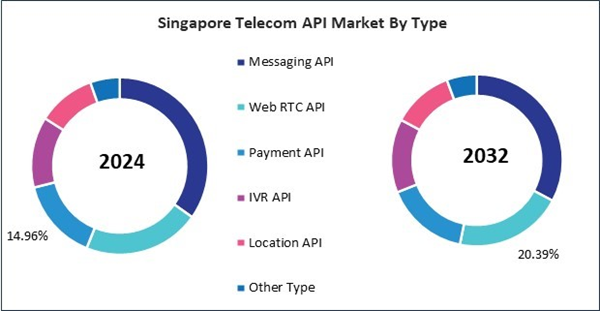The China market dominated the Asia Pacific Telecom API Market by country in 2024, and is expected to continue to be a dominant market till 2032; thereby, achieving a market value of $99.48 billion by 2032. The Japan market is registering a CAGR of 22% during 2025-2032. Additionally, the India market is expected to showcase a CAGR of 23.6% during 2025-2032.
IoT (Internet of Things) applications leverage Telecom APIs to enable device connectivity and data exchange in smart homes, industrial automation, and connected vehicles. These diverse applications demonstrate the versatility of Telecom APIs in addressing the needs of industries ranging from retail and finance to healthcare and transportation. The adoption of Telecom APIs has accelerated in recent years, driven by the growing need for businesses to deliver seamless, scalable, and personalized communication experiences. Enterprises across sectors are increasingly integrating APIs to enhance operational efficiency and customer engagement.
For instance, startups and small businesses, which often lack the resources to build proprietary communication systems, rely on Telecom APIs to quickly deploy scalable solutions. Large enterprises, on the other hand, use APIs to modernize legacy systems, enabling them to compete in a digital-first market. The rise of cloud-based platforms has further fueled adoption, as APIs are often hosted in the cloud, offering flexibility, scalability, and ease of integration. Telecom operators themselves are embracing APIs as a means to monetize their network assets, moving beyond traditional voice and data services to offer value-added services.
The Asia Pacific region is one of the fastest-growing markets for Automotive Energy Recovery Systems (ERS), driven by rapid industrialization, urbanization, and growing environmental awareness. Countries such as China, Japan, South Korea, and India are at the forefront of this expansion, supported by government mandates for cleaner vehicles and increasing investments in electrified transport. The region is characterized by a diverse automotive landscape - from high-volume low-cost vehicles to advanced electric and hybrid models - which creates a broad spectrum of demand for ERS technologies.
As Asia Pacific continues to cement its status as the world’s largest automobile producer and consumer, the need for energy-efficient systems like ERS has become increasingly urgent and strategic. The Asia Pacific ERS market is highly competitive and fragmented, with a mix of domestic giants, global automakers, and Tier 1 suppliers vying for market share. Major automotive OEMs such as Toyota, Hyundai, BYD, Tata Motors, and Honda are aggressively integrating ERS in their electrified fleets.
In parallel, global component suppliers like Denso, Hitachi Astemo, and Mitsubishi Electric are expanding their presence in the region with ERS solutions tailored for local markets. Additionally, emerging local players and joint ventures are entering the market, focusing on cost-effective ERS systems to serve price-sensitive segments. The region's intense competition is also stimulating rapid innovation cycles, where modularity, cost-efficiency, and integration ease are key selling points. Still, with a rapidly growing EV base and increasing government support, the Asia Pacific region is poised to be a dominant force in the global ERS landscape.
List of Key Companies Profiled
- Adobe, Inc.
- Avaya, Inc. (Avaya Holdings Corp.)
- Deutsche Telekom AG
- IBM Corporation
- Microsoft Corporation
- Amazon Web Services, Inc. (Amazon.com, Inc.)
- AT&T, Inc.
- Verizon Communications, Inc.
- Ericsson AB
- Twilio, Inc.
Market Report Segmentation
By End User
- Partner Developers
- Enterprise Developers
- Internal Telecom Developers
- Long Tail Developers
By Type
- Messaging API
- Web RTC API
- Payment API
- IVR API
- Location API
- Other Type
By Country
- China
- Japan
- India
- South Korea
- Singapore
- Malaysia
- Rest of Asia Pacific
Table of Contents
Companies Mentioned
- Adobe, Inc.
- Avaya, Inc. (Avaya Holdings Corp.)
- Deutsche Telekom AG
- IBM Corporation
- Microsoft Corporation
- Amazon Web Services, Inc. (Amazon.com, Inc.)
- AT&T, Inc.
- Verizon Communications, Inc.
- Ericsson AB
- Twilio, Inc.









